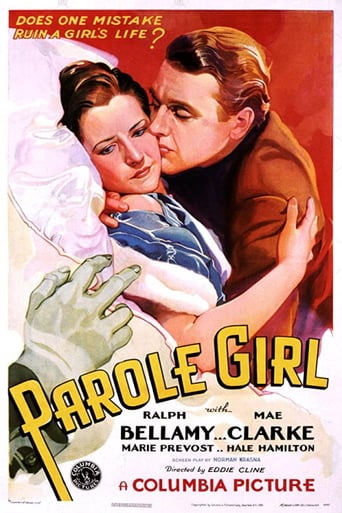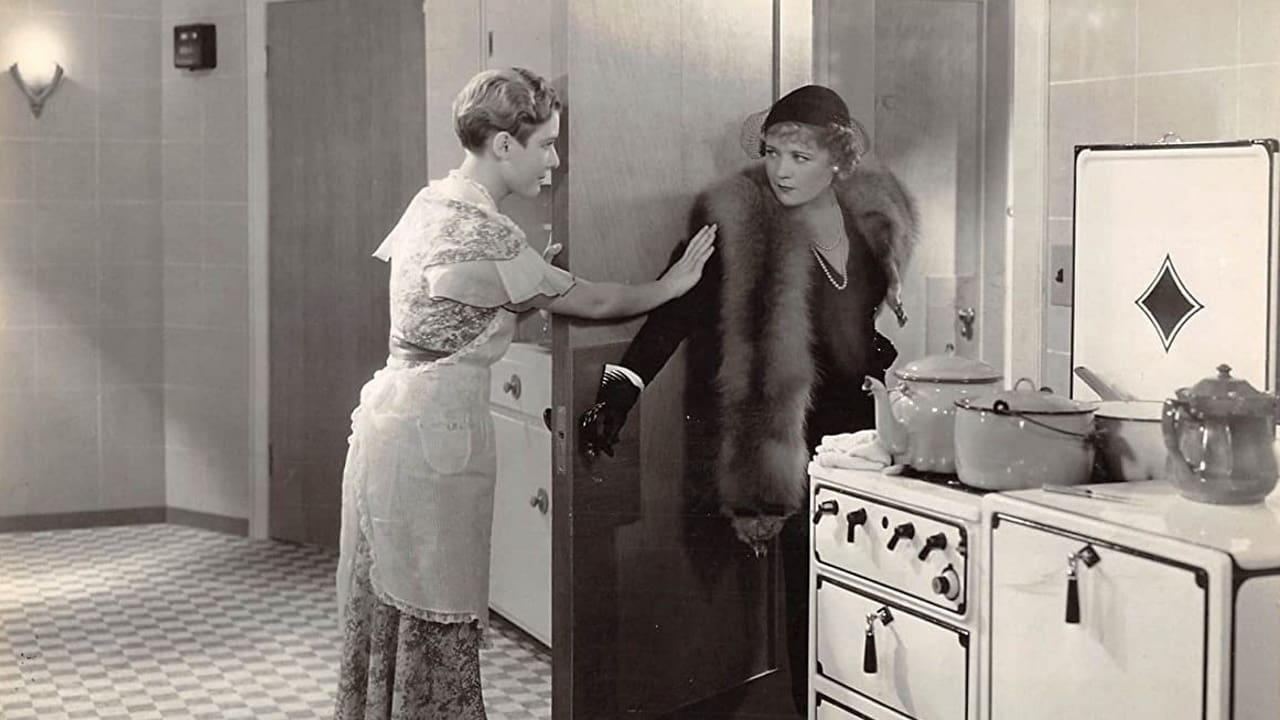Richard Chatten
With a title like that - and with Mae Clarke best remembered today as a punchbag for Jimmie Cagney - one approaches this film expecting gritty lowlife drama. This expectation is reinforced by an extremely atmospheric opening sequence (which makes excellent use of tracking shots and realistic sound), seemingly shot in a genuine department store, with store detective Lee Phelps pursuing Miss Clarke as she heads for the exit after a customer loudly accuses her of picking his pocket. She ends up going to jail after the manager of a different store, Ralph Bellamy, refuses her pleas for mercy for a different offence (Bellamy's explanation that "the store's rule has always been to prosecute, our insurance company insists upon it" carries the hint that the brutal, unyielding capitalist system bears some of the blame for her plight); and her time in jail culminates in a superbly staged sequence set in the prison workshop when she demonstrates neither for the first or last time her adroitness as a manipulator by deliberating starting a fire and then 'heroically' turning an extinguisher on it.The film's title and her journey through the lower depths can in retrospect can be seen as Depression-era window dressing serving as a prologue to the vengeful game of marital cat-&-mouse Clarke then begins at the expense of the hapless Bellamy when she emerges from prison, which comprises the rest of the film. Five years earlier with a racier title implying sexual rather than criminal intrigue this story could easily have been a vehicle for the likes of Norma Shearer, with both the many preposterous plot contrivances resembling those of a silent film, and Clarke's chic boyish haircut reinforcing her resemblance to a silent film heroine. Aided by elegant photography by the great Joseph August, Eddie Cline so deftly handles both the early action & drama and the later scenes of sexual tension that it may after all be worth investigating his filmography beyond the vehicles for W.C.Fields with which his name is associated.A charming cameo by Ferdinand Gottschalk as Bellamy's boss deserves particular mention in a uniformly good cast; and Mae Clarke here turns in a real star performance displaying a wide emotional range as well as a rapport with Bellamy. Unfortunately she was on the very brink of a precipitous fall from grace as the result of the double-whammy of a nervous breakdown brought on by overwork in June 1932, followed by a car accident in which her jaw was broken the month 'Parole Girl' was released in March 1933. She thus well exemplifies that lost generation whose work continues to surprise and delight discoverers of pre-Code Hollywood.
jarrodmcdonald-1
Mae Clarke and Ralph Bellamy have excellent chemistry in Parole Girl. But what really puts this film on the map is its ability to take a theme like revenge and make a routine prison film into something more. Here, it becomes an unlikely romance. The supporting characters enliven the proceedings. There's the friend who throws the apple out the window on the train, and the boss who comes to dinner but enjoys sitting in the kitchen. But the most interesting bit occurs earlier in the picture. It's a dramatic prison fire scene, and it is one of the best-staged action scenes this writer has viewed in a long time.
kidboots
It promises gritty, hard hitting pre-code earthiness and it almost delivers. Supposedly based on the story "Dance of the Millions" but, really, it is a re-working of Bayard Veiller's popular play "Within the Law". It had already been given the 4 star treatment at MGM as "Paid" (1930) with Joan Crawford. The link between the two movies is sweet Marie Prevost, who played a similar character in both - a ditsy cell mate who teams up with Mae/Joan when they are paroled. Poor Marie spent almost as much time behind bars as Sylvia Sidney. "Everything I do is on the level" to which Mae replies "Well, since you've been in prison - blackmail, larceny and extortion are now crimes"!!!It is interesting, when you view Mae Clarke's performances, she has sincerity and honesty in every part she plays but she just couldn't make the leap to the A grade. Her films were excellent "Waterloo Bridge" and "Night World" etc but by 1933 her bid for stardom was over and "Parole Girl" was described as "bottom of the barrel". It certainly wasn't that!!! While it wasn't in the same league as MGM's "Paid" - it was a perfect vehicle for Mae.Sylvia Day (Mae Clarke) is accused of picking a gentleman's pocket in a department store. She is dragged, humiliated in front of customers, to the manager's office, but it is all a misunderstanding. Then Sylvia goes into her award winning performance - she cries, she sobs and she walks out with a cheque for $500. But it is all a scam - she and the "gentleman", Tony (Hale Hamilton) are working together and while Sylvia is determined to go straight she is persuaded to do one last job. Of course they are caught and she comes up against a stony store manager, Joe Smith(Ralph Bellamy) who is not softened by her pleas for leniency. She is sent to prison for a year and after her release her only thought is to make Smith pay - and pay he does!!! After renewing his acquaintance (he doesn't know her), she gets him "cockeyed" and he wakes up next morning - married!!! Of course it is all bogus as Tony has performed the ceremony.From now on a lot of the grittiness goes and is replaced by pre- code fun as Sylvia glides around in assorted negligees. Mae Clarke does sport an unattractive "butch" hairstyle and I am glad this seems to be the only film that she chose to wear it. There are a couple of glitches to their happiness. Tony is upset that Sylvia has thrown him over and plans to get even with her by slipping a counterfeit bill in her purse but Joe, unexpectedly, comes to her rescue and they really start to fall in love. Then Joe's wife appears - yes, he is already married and to none other than Jeannie (Marie Prevost) Sylvia's little pal from the big house. But everything is smoothed out and all under 70 minutes. After all this was in 1933 when they really knew how to make movies.Highly Recommended.
classicsoncall
Despite the high degree improbability of it all, this turned out to be a fairly entertaining picture. Hopefully with today's offering on Turner Classics, this film might put together the requisite number of votes to get a rating on this board. It has some of the appeal found in the exploitation flicks of the same era, but with writing and direction that places it a notch above.The story involves a young woman who gets tangled up with a smarmy con man (Hale Hamilton) doing a pickpocket grift that leads to a shakedown at targeted retail stores. When Sylvia (Mae Clarke) gets busted and sent to prison for a year long stretch, she plots her revenge against the insurance adjuster who wouldn't bend the rules to let her off easy in the first place. That angle might have played out a lot more believably if one of Sylvia's prison buddies (Marie Prevost) hadn't been involved with the same guy (Ralph Bellamy) a couple of years earlier. In one of the wildest stretches of imagination, both ex-cons duped the gullible Joe Smith (seriously, not an alias) into a phony marriage. Obviously, a whole lot of thought wasn't put into this story, but that's what they came up with.Naturally, this one plays out with Smith and Sylvia hooking up together for real once they discover they have feelings for each other following a series of events that bring out their better natures. Not entirely unexpected, but again, it takes a bit of a stretch to get there.Veteran character actor Ralph Bellamy eventually went on to become a well regarded and respected performer, even though he never made it as a major headliner. Mae Clark is probably best known for taking a grapefruit in the kisser from Jimmy Cagney in 1931's "The Public Enemy". Their hook-up here doesn't involve too much chemistry, but considering the circumstances, that's to be expected. The thing that I kept wondering about was how a couple of ex-jailbird floozies like Sylvia and Jeanie always walked around in such fashionable clothes.Addendum dated 10/17/09: Forty eight hours ago, this film didn't have the minimum five votes needed to insure an IMDb rating, nor did it have a single review. As I write this, the film has twenty two votes and four comments. I read that as a testament to the dedication serious cinema fans apply to their entertainment, particularly as it applies to films offered on Turner Classics. I have seen a similar pattern for prior TCM offerings, and would like to thank and encourage those viewers for going the extra mile in pursuit of their passion and interest.


 AD
AD


